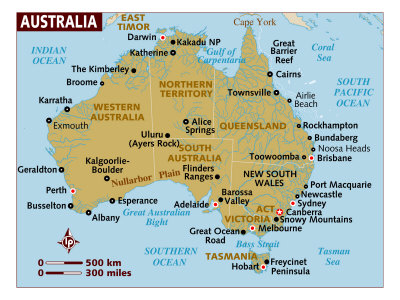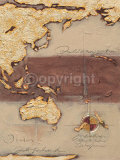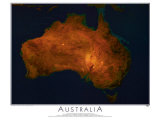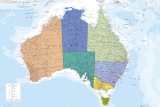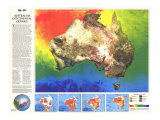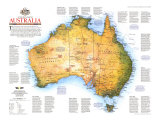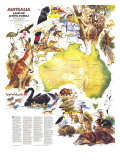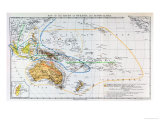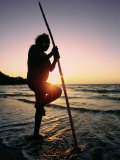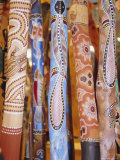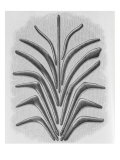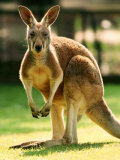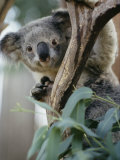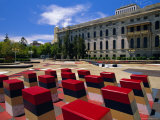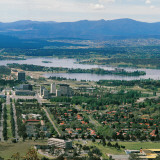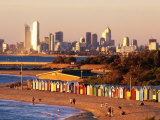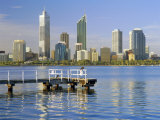|
|
Australia & Australian Culture Posters, Prints, & Maps, pg 1/3
|
geography > AUSTRALIA pg 1 | pg 2 | Australia National Parks < social studies
|
Australia, the only nation to occupy an entire continent, is also made up of numerous small islands in the Pacific, Indian and Southern Oceans. The country of New Zealand is to the southeast of Australia, Indonesia, East Timor and Papua New Guinea are to the north, and the Solomon Islands, Vanuatu and New Caledonia are to the northeast.
Canberra is the capital of Australia. There are six states – New South Wales, Queensland, South Australia, Tasmania, Victoria, and Western Australia; two mainland territories – Northern Territory and Australian Capital Territory; and Jervis Bay, Christmas Island and Cocos Islands, Ashmore and Cartier Islands, Coral Sea Islands, Heard and McDonald Islands, and the Australian Antarctic Territory.
The Australian Continent has been occupied by indigenous peoples for at least 42,000 years. The common term Aborigines evoked by the European settlers included hundreds of cultures and communities with a great variety of languages, environments and technologies. European explorers of Australia include Willem Janszoon, Luis Váez de Torres (namesake Torres Strait), Dirk Hartog, Frederick de Houtman, Abel Tasman, Willem de Vlamingh, William Dampier, James Cook, George Bass (Bass Strait), Matthew Flinders, and John Eyre.
The name Australia is from Australis, the Latin for “The South”. Australia is refered to as the “land down under” because of its location in the southern hemisphere. Australia is also the driest inhabited continent, the flattest, and has the oldest and least fertile soils.
With the loss of the American Colonies, Great Britain moved its penal colony to Australia in 1788. More Crown Colonies were formed over the continent in the next century, eventually leading to their federation and establishing the Commonweath of Australia in 1901.
|
|
|
|
|
Continent of Australia
Poster Text:
PHYSICAL FEATURES/CLIMATE
Australia lies completely below the equator, so its seasons are the opposite of those in the Northern Hemisphere. Summer lasts from December through February, while winter lasts from June through August. The climate in Australia is generally warm and dry. The majority of the continent is desert. Along with the eastern coast, summers are warm, winters are cool, and rainfall is moderate. Heavy rainfall from storms and cyclones cause floods along the north coast during the rainy season, from November to April. Droughts are a problem in nearly all parts of the continent. The Australian Alps, a small mountain range in the south, is the only area that gets snow in the winter. The Great Barrier Reef, the world's largest coral reef, extends for aobut 1,500 miles along Australia's northeast coast.
RESOURCES: Because of a lack of water, Australia has little land that can be farmed. However, the continent is the world's top producer of wool and a large producer of beef. Australia also has rich mineral deposits. It is the leading supplier of bauxite, an important ore used in making aluminum. Australia is a leading producer of diamonds, lead, coal, copper, gold, and other minerals. Petroleum and natural gas are drilled in off-shore wells. The continent also has large depostis of uranium.
WILDLIFE: Experts believe that at one time, all seven continents were part of one large land mass. But Australia has been separated from the rest of the world by huge oceans for about 60 million years. Because of this, its animals evolved differently from those on the other continents. Australia has more than 150 varieties of marsupials – mammals were tiny young develop in their mothers' pouches. These marsupials include kangaroos, koalas, wallabies, and wombats. The platypus and the echidna, which are also found in Australia, are the only mammals that hatch their young from eggs. Eucalyptus and acacia are two of the continent's most common native plants.
HISTORY/PEOPLE: Native Australian, known as Aborigines, lived in Australia for 40,000 years before the first white settlers arrived. In the late 1700s, the British settled Australia as a prison colony. Many of the aborigianl Australians were killed or forced from their homes by these settlers. Until the mid-1900s, almost all immigrants to Australia were from England or Ireland. After World War II, people left homeless by the war were encouraged to settle there. Today, less than 1 percent of the population of Australia is made up of Aborigines. Most Australians are European immigrants or the children of European immigrants. About 4 percent of the population is Asian. The majority of the people in Australia live along the southeast coast, because the inland climate is too dry to support a sizeable population.
* The island of New Zealand is not considered part of the continent of Australia, New Zealand and many other Pacific islands are not geographically part of any continent. The collective name for these island is Oceania.
• continent posters
|
|
|
|
|
|
|
|
|
|
Kangaroo are native to Australia and the name was first recorded by Captain Cook in 1770. Kangaroos, which are marsupials, range throughout Australia and are considered a national symbol.
|
|
|
|
The Koala is an arboreal marsupial herbivore native to Australia. The koala is not a bear though English-speaking settlers from the late 18th century first called it koala bear due to its similarity in appearance to bears.
Koalas sometimes eat the leaves of Eucalypt trees that can be found in almost every part of the Australian continent.
|
|
|
|
The Tasmanian Devil is the largest carnivorous marsupial in the world and is only found on the Australian island state of Tasmania.
|
|
|
|
Adelaide, the fifth largest city in Australia, is located on the southern coast at the eastern shores of Gulf St Vincent, on the Adelaide Plains, north of the Fleurieu Peninsula, between Gulf St Vincent and the low-lying Mount Lofty Ranges. Adelaide was founded in 1836 and named in honor of Adelaide of Saxe-Meiningen, queen consort to King William IV.
Notable people associated with Adelaide include Dame Judith Anderson, J. M. Coetzee, Rupert Murdoch.
|
|
|
|
Canberra, Australia's national capital, is the nation's largest inland city and the eighth-largest city overall.
Canberra is a planned city, and was sited between Sydney and Melbourne. The architect was Walter Burley Griffin and his wife Marion Mahony Griffin.
|
|
|
|
Melbourne, the second most populous city in Australia, after Sydney, is located on the south coast.
It was founded in 1836 and declared a city by Queen Victoria in 1847, being named after the British Prime Minister William Lamb — the 2nd Viscount Melbourne (his wife was Lady Caroline Lamb).
Melbourne became the wealthiest city in world during the Australian gold rush of the 1850s.
Notable people associated with Melbourne: Cate Blanchett, Helen Caldicott, Germaine Greer, Nellie Melba, Olivia Newton-John, Helen Reddy.
|
|
|
|
Perth is the capital and largest city of the Australian state of Western Australia and the fourth most populous city in Australia at 1,700,000 people.
Perth is in the top ten of the most livable world cities.
|
|
|
|
The Sydney Opera House, a UNESCO World Heritage Site, s one of the 20th century's most distinctive buildings and one of the most famous performing arts centers in the world.
FYI - The opera house is built on a point of land in the Sydney Harbor named after Bennelong, an indigenous Australian who served as an interlocutor between the Eora and the British.
• more architecture posters
• opera posters
|
|
|
|
Opal is the national gemstone of Australia, producing 97% of the world's opals.
|
|
|
|
Dry Lake Bed
A large basin most of the time, Lake Eyre is the largest lake in Australia when filled with water during the rainy season.
Lake Eyre is named for British explorer Edward John Eyre who was the first European to travel the Great Australian Bight coastline by land.
|
|
|
previous page | top > AUSTRALIA pg 1 | pg 2 | Australia National Parks
|
|
I have searched the web for visual, text, and manipulative curriculum support materials - teaching posters, art prints, maps, charts, calendars, books and educational toys featuring famous people, places and events - to help teachers optimize their valuable time and budget.
Browsing the subject areas at NetPosterWorks.com is a learning experience where educators can plan context rich environments while comparing prices, special discounts, framing options and shipping from educational resources.
Thank you for starting your search for inspirational, motivational, and educational posters and learning materials at NetPosterWorks.com. If you need help please contact us.
|
|
|



















